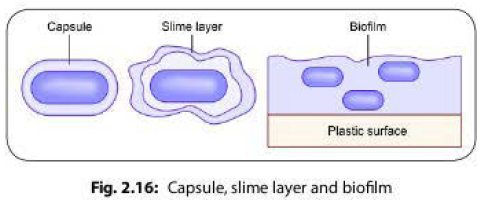Bacterial capsule or a slime layer is a layer of amorphous viscid material lying outside the cell wall called glycocalyx.
When the glycocalyx layer is well organized and not easily washed off, it is called capsule (Fig. 2.16).
When the glycocalyx layer is in the form of diffuse, unorganized loose material that can be removed easily, it is called slime layer (Fig. 2.16). (Some bacteria may possess both capsule and slime layer, as in Streptococcus salivarius)
Examples of bacteria having capsule and
slime layer
- Most of the bacterial capsules are polysaccharide in nature (Table 2.6), except in Bacillus anthracis where it is polypeptide in nature. Capsule is also seen in fungi, e.g. Cryptococcus neoformans.
Functions of Bacterial Capsule and Slime
Layer
Bacterial capsule has various functions as follows:
- Contribute to bacterial virulence:
- Capsule protects the bacterium from phagocytosis.
- It can also prevent complement mediated bacterial cell lysis.
- Prevent cell from drying out (desiccation)
- It protects the bacterium from the action of lysozyme and bacteriophages.
- Capsule of certain bacteria ( e.g; Bacteroides fragilis) may be toxic to the host cells and induces abscess formation
- Biofilm formation and adhesion:
Biofilm Formation
- A biofilm is a living ecosystem made of millions of adherent bacterial cells embedded within a self produced matrix of extracellular polymeric substance (i.e. the polysaccharide slime layer).
- Persistent biofilms containing pathogenic bacteria are capable of adherence to damaged tissues and plastic surfaces (e.g. medical devices, such as catheters and pacemakers).
- This is the first step in bacterial colonization and sometimes it leads to disease, e.g. prosthetic valve endocarditis and catheter related urinary tract infection (Fig. 2.1 6).
- Source of nutrients and energy: Capsules can be a source of nutrients and energy to microbes. Streptococcus mutans, which colonizes teeth, ferments the sugar in the capsule and so formed acid by-products contribute to the tooth decay.
- Capsules as vaccine: Capsules of few bacteria are antigenic and anticapsular antibodies are protective in nature. Hence, capsular antigens of many bacteria are used as potential vaccine candidates. Capsular vaccines are available for bacteria, such as pneumococcus, meningococcus and Haemophilus influenzae serotype-b.
Demonstration
of Bacterial capsule
- Capsule can be detected by various methods as follows:
- Negative staining by India ink and nigrosin stain:
- Capsule appears as a clear refractile halo aroundthe bacteria where as both the bacteria and the background appear black.
- M'Faydean capsule stain: It is used for demonstration of capsule of Bacillus anthracis by using polychrome methylene blue stain.
- Serological test: Capsular material is antigenic and can be demonstrated by mixing it with a specific anticapsular serum.
- Quellung reaction: Capsular serotypes of Streptococcus pneumoniae can be detected by adding antisera mixed with methylene blue. Capsule becomes swollen, refractile and delineated.
- Capsular antigen: It can be detected in the sample (e.g. CSF) by latex agglutination test by using specific anticapsular antibodies coated on latex particles. This is available for Pneumococcus, Cryptococcus, Haemophilus influenza and meningococcus.



No comments:
Post a Comment